1950 Penny Value – With its iconic design featuring wheat stalks on the reverse side, the 1950 penny holds a special place in the hearts of many collectors. But beyond its sentimental value, what is the actual worth of a 1950 penny?
In this blog post, we will delve into the world of numismatics and uncover the true 1950 penny value, specifically focusing on the 1950 wheat penny value.
So grab a cup of coffee and join us as we explore the fascinating history and value of this iconic coin.
The Lincoln penny has been a staple in American coinage for over a century, and the 1950 Lincoln penny is a favorite among collectors. These coins are sought after for their scarcity and historical significance.
On the obverse, you’ll find a detailed image of Abraham Lincoln, with inscriptions for “Liberty” and the year of minting.
The reverse side features the inscriptions “United States of America” and “One Cent,” along with two wheat stalks and the phrase “E Pluribus Unum.”
With over half a billion produced in 1950, these pennies are not difficult to find and can be purchased for about 10 cents in circulated condition. However, proof versions of the 1950 penny can fetch higher prices, ranging from $50 to $100 or more.
Collectors should look for well-preserved examples and pay attention to mint marks for increased value.
History Of The 1950 Wheat Penny
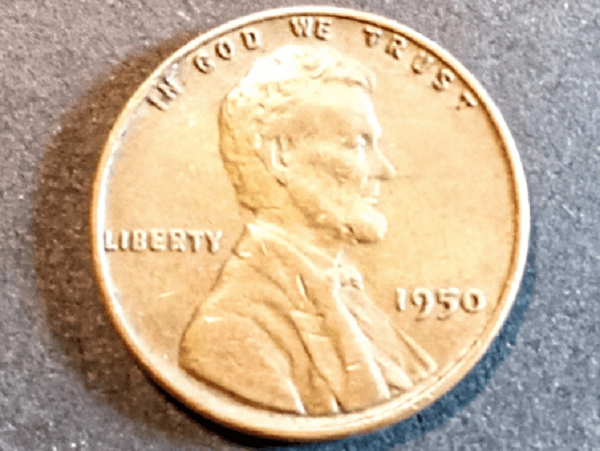
The history of the 1950 Wheat penny is intertwined with the broader history of Wheat pennies in American numismatics. These coins hold great significance, as they were the first to feature the likeness of a real person on them.
Before the introduction of the Lincoln penny in 1909, the US Mint adhered to the practice of not putting the faces of real people on coins, in contrast to the ruling monarchies in Europe.
However, with America’s newly gained independence, there was a desire to distance itself from those customs.
How Much is a 1950 Penny Worth?
1950 Penny No Mint Mark
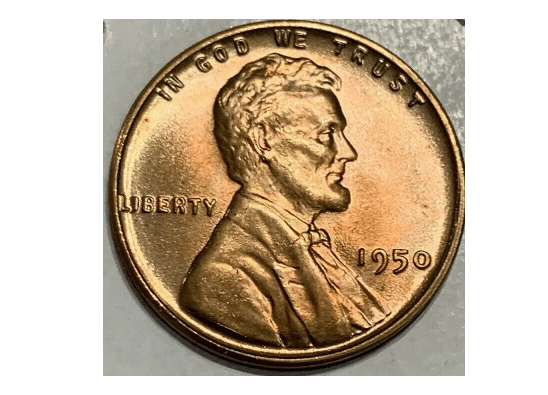
The 1950 Lincoln penny is a highly sought-after coin among collectors. With over 272 million pennies struck at the Philadelphia Mint, their value is relatively low compared to other years. However, this means that these coins are readily available on the market.
Circulated brown 1950 pennies can be found for as low as $0.03 to $0.07, while mint state examples up to MS 64 can be purchased for less than a dollar.
The price increases for higher-graded coins, with MS 67 examples selling for $35 to $45.
Red pennies tend to be more expensive, with prices ranging from $2 to $84 for MS 63 to MS 66 graded coins, and up to $800 to $960 for MS 67 graded coins.
The most expensive 1950 Philadelphia penny sold for an astonishing $10,575 at an auction in 2020. So, while the value of the 1950 penny may not be extremely high, it is still a fascinating coin to collect and explore.
1950-D Lincoln Penny
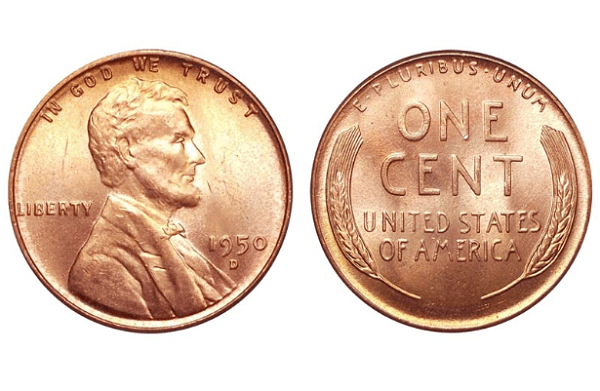
The 1950-D Lincoln penny struck at the Denver Mint, is abundant on the rarity scale. With a mintage of 334,950,000, it ranks as the 9th highest of all the Wheat years.
This marked the beginning of a trend where the Denver Mint outpaced the main Philadelphia Mint in production.
Today, you can find quantities of 1950-D pennies available in both mint state and circulated grades. When inspecting these coins, collectors look for standout examples with even color and sharp design.
Slight wear is expected in circulated pieces. The 1950-D penny is a fascinating piece of history that holds value for collectors and enthusiasts alike.
1950-S Lincoln Penny
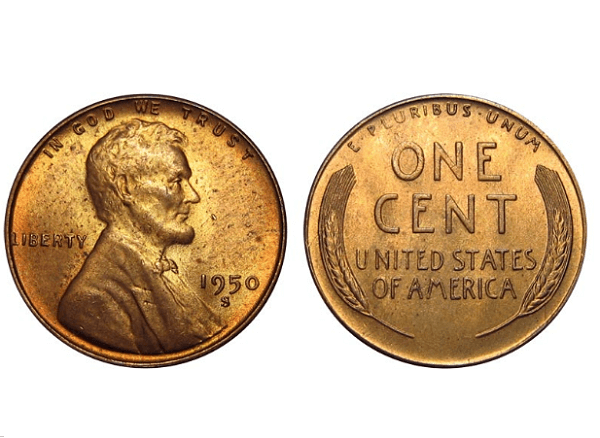
The 1950-S Lincoln penny struck at the San Francisco Mint, is considered abundant on the rarity scale. With a mintage of 118,505,000, it continued the trend of being the lowest-produced coin that year.
Despite its abundance, a circulated 1950 S penny still holds a small premium. Collectors are particularly interested in lightly circulated or finer examples, as a well-defined coin with distinct grains of wheat on the reverse sets it apart.
An awareness of the low coinage numbers combined with its overall popularity forms a firm base for valuing the 1950-S Lincoln penny.
1950 Wheat Penny (Proof) Value
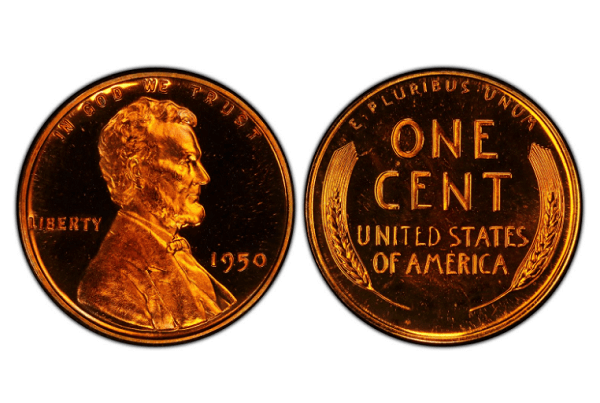
Get ready to dive into the exciting world of 1950 Wheat penny proofs!
- The Philadelphia Mint struck 51,386 proofs that year and their value is significantly different from regular coins.
- Brown proofs in grades PR 60 to PR 66 can range from $23 to $60, while those with a PR 67 rating can go for $200 to $230.
- Red-brown proofs typically cost a bit more, with prices ranging from $28 to $66 for PR 60 to PR 66 graded specimens, and $225 to $260 for those with a PR 67 ranking.
- Red 1950 pennies are the most valuable, especially those with the CAM and DCAM contrast.
- PR 66-graded red pennies can be worth anywhere from $32 to $75, while PR 67-graded examples can sell for around $260.
- The most expensive in the series is the PR 68 graded coin, which can be priced between $1,100 and $1,265.
When it comes to 1950 RD CAM pennies, prices depend on the quality, ranging from $65 to $78 for PR 64 graded coins, $110 to $132 for PR 65 graded coins, $275 to $325 for PR 66 graded coins, $800 to $920 for PR 67 graded coins, and $3,500 to $4,025 for PR 68 graded coins.
As expected, red DCAM Wheat pennies are the most expensive proofs from 1950.
Prices for these can range from $160 to $190 for PR 64 graded coins, $500 to $600 for PR 65 graded coins, $960 to $1,100 for PR 66 graded coins, $4,200 to $4,830 for PR 67 graded coins, and $17,500 to $20,125 for PR 68 graded coins.
In fact, the most expensive sold proof from 1950 was a red DCAM specimen graded PR 68, which was purchased for an astonishing $19,975 at an auction in 2017.
Grading the 1950 Lincoln Penny
To grade the 1950 Lincoln penny, the condition of the coin is of utmost importance to collectors.
Graded coins are the ones that collectors seek out, as they have been preserved and are in the best condition.
- An Uncirculated 1950 Lincoln penny is one that has never been in circulation, preserving its blemish-free appearance.
- Extremely Fine-grade coins have avoided heavy circulation but may have a few small flaws.
- Fine-grade coins have been circulated for a good amount of time but have managed to avoid major damage.
- Good-grade coins have been heavily circulated and will show signs of wear and damage. The flaws on these coins can range from light scratching to intense smoothing.
Understanding the different grades can help determine the value and desirability of a 1950 Lincoln penny. So, if you’re lucky enough to have one, make sure to evaluate its condition to uncover its potential value.
1950 Penny Errors List
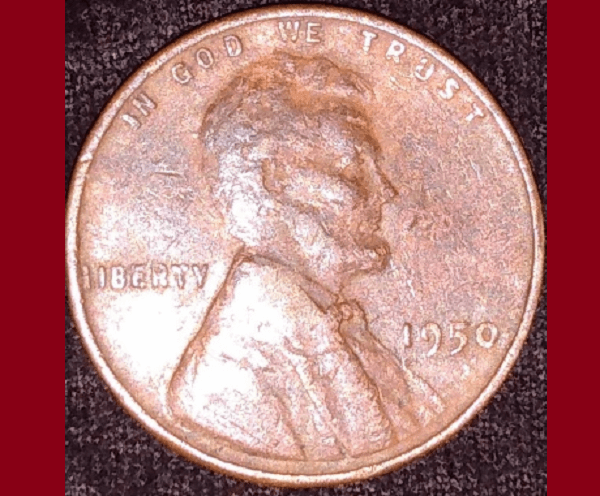
Rare errors can greatly increase the value of a 1950 wheat penny.
- One such error is the BIE mint error, which occurs when there is a die break in the word LIBERTY, creating a raised mark that resembles the letter I. This error can increase the coin’s value to $10.
- Another error to look out for is the broad strike, where parts of the design are missing due to a broken collar during minting. The value of these specimens can range from $5 to $100.
- The off-center error is also quite valuable, with the value depending on how much of the design is missing. If the defect is close to 60%, the coin can be worth up to $300.
- The DDO error, caused by doublings on the surface of the die, can be found for $3 to $120.
- The re-punched mint mark error occurs when the mint mark is mistakenly struck twice and these coins typically have lower prices ranging from $5 to $16.
These rare errors make 1950 wheat pennies even more desirable to collectors and potentially more valuable.
Is a 1950 penny rare?
The 1950 penny, rarity is a key factor that makes it highly sought after by collectors. Being an old coin adds to its value, as there are fewer 1950 pennies in circulation compared to newer ones.
The number of well-preserved 1950 pennies is decreasing over time, making it even more important for collectors to acquire them before they become even scarcer.
Its rarity, along with any unique errors it may have, can significantly increase its value. So don’t overlook the potential value of a 1950 penny in your collection!
What is the value error on a 1950 penny?
In determining the value of a 1950 penny, the presence of errors can greatly impact its worth. One such error is the off-center error, where the penny was irregularly struck during minting, resulting in a crescent-shaped defect.
The value of this error depends on how much of the design is missing, the closer the defect is to 60%, the higher the value.
However, it’s important to note that the minting date and mint mark must still be visible for the error to hold significant value. In the case of the 1950 off-center error penny, its value can reach up to $300.
Conclusion
The 1950 penny holds both sentimental and monetary value. While the 1950 Lincoln penny is not particularly rare or expensive, it is a favorite among collectors for its historical significance and iconic design.
The value of a 1950 penny depends on factors such as its condition, mint mark, and any potential errors or variations.
The 1950 wheat penny, also known as the 1950 one cent penny, has a worth beyond its face value, especially when considering its condition and any unique errors it may possess.
Grading the 1950 Lincoln penny is crucial for collectors, with uncirculated coins being the most desirable. The presence of rare errors, such as the BIE mint error or the off-center error, can greatly increase the value of a 1950 penny.
So, if you have a 1950 penny in good condition with any of these errors, you may have a valuable treasure on your hands. Remember, the rarity and error value plays a significant role in determining the worth of a 1950 penny.
Related Articles: